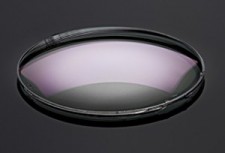Myeyewear2go.com-How to Clean and Handle Glasses with Anti-Glare Coating

Middlesex, NJ, December 21, 2016 (Newswire.com) - Anti-glare coatings (also referred to as anti-reflective AR coatings) are applied to eyeglasses and sunglasses to reduce or eliminate the unwanted light that enters the vision field. Two uncomfortable and sometimes disabling sources of light pollution are glare - an uncontrolled and excessive brightness; or halos - bright circles surrounding a light source.
If you drive at night and are troubled by the brightness of oncoming headlights; that is one example of halo discomfort. In addition, during the daily commuting hours when the sun is setting or rising, glare from the sun can be so debilitating that motorists risk an accident if they don't pull over or make visual adjustments. Other sources of glare discomfort (or disability) in addition to driving, include working at computer screens, overhead lighting (especially while reading), sunny day at the beach, outdoors on snowy days, and watching television.
The best option for reducing unwanted glare is to have an AR coating factory applied to your eyewear. Multiple layers of an optical coating are applied to the front, back, or both surfaces of lenses to reduce the reflection of light on your eyewear lens. This is an appealing cosmetic feature because it makes the eyes more visible to those at which the wearer is looking.
At the same time, anti-reflective ophthalmic coatings effectively reduce glare by allowing only "good light" to enter the eye, increasing contrast and visual acuity. The thin, transparent film is sensitive to scratching and must be handled carefully and cleaned appropriately to last longer and remain in pristine condition.
How to Care For and Clean Glasses with Anti Glare Coating
In normal conditions, the anti-glare coating on your glasses will last for years; long enough to sustain the wearer through the traditional two to three years before visual changes demand a new prescription. Since the factory applied coatings lie on the surface of the lens, the following tips will ensure against damage:
- It is best to always store this eyewear in a protective hard case when not wearing, to prevent accidental scratching. Fold and lay glasses on surfaces with the lens-side up so that the surfaces are not rubbing against anything.
- Do not put unprotected glasses in your shirt pocket, purse or pants pockets. Not only will you risk bending the frames, but these types of hostile environments don't stand up to scratch resistant coatings.
- Lens coatings can be damaged by heat, also. Extreme temperatures like hot water or resting on sun-riddled dashboards can warp the frames. Lens coatings also expand and contract at different rates from the base lens material, causing a network of fine cracks throughout the coating (referred to as crazing).
- Do not use strong solutions, like Windex, acetone, alcohol, or ammonia-based solutions on coated glasses. These chemicals will degrade the coating over time and diminish the anti-glare efficiency of the glasses.
- Avoid wiping glasses when they are dry or have dirt on them. Grinding dirt particles into the coating is the most common way individuals scar the lens surface of AR-coated glasses.
How Best to Clean Anti-Glare Coated Eyewear
Your optician will likely suggest a professional cleaning solution at the point of purchase to keep your new eyewear clean and scratch free. If the need arises to buy a commercial brand cleaning solution, select one that is designed for anti-reflective coatings.
Ask your eye care provider about the type of coatings that have been applied to your eyewear and any special instructions on handling or cleaning. If using a commercial lens cleaner, follow the manufacturer's directions as given on the label, otherwise simply use the following guidelines:
1. Prepare the lenses for cleaning by rinsing under warm running water. This method is more efficient than submerging your glasses in a bowl of water.
2. Once eyeglass lens debris is rinsed away, apply gentle soap diluted with water or an AR lens cleaner to the wet glasses. Gently rub the lenses with fingertips or a soft, preferably microfiber cloth, to thoroughly clean the glasses.
3. After cleaning, it is important to rinse all soap from the glasses, using running water. After all soap residue is removed, shake excess water from glasses.
4. To prevent water spots, immediately dry glasses with a lint-free, microfiber cloth until they are completely dry.
Contact us for a large selection of fashionable and sports-wear eyeglasses and sunglasses.
Source: Myeyewear2go